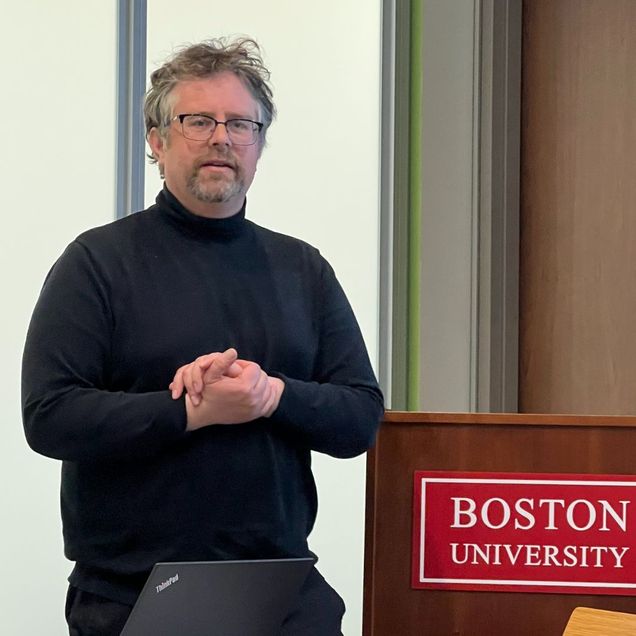IGS Visiting Researcher Presentations Cover Industrial Decarbonization and Growing Social Influence of EU Amid Clean Energy Transition
By Alison Gold
Many of history’s greatest technological and social advancements arose from societies’ efforts to meet challenging moments. The clean energy transition is shaping up to be no exception. As corporations and governments strive to reduce emissions and mitigate the climate crisis, new ways of governing and doing business are emerging.
At BU’s Institute for Global Sustainability (IGS), experts from many disciplines convene to support countries, states, communities, and industries in realizing a more just and sustainable future. Through IGS’s Visiting Researcher Program, scholars from around the world join the vibrant IGS community, traveling to Boston to contribute fresh perspectives to this critical work.
While IGS’s two newest Visiting Researchers come from two very different fields — green engineering and political science — they share a desire to understand how major institutions can, and already are, transforming amidst the clean energy transition. Recently, they presented their research to a packed room of IGS faculty, staff, and students.
- Thomas Alan Kwan, Vice President of Sustainability Research at Schneider Electric (named the World’s Most Sustainable Corporation both by Time and Corporate Knights in the past year), discussed his research on economic opportunities in industrial decarbonization.
- Johan Nordensvard, an associate professor at the Royal Institute of Technology KTH and associate professor in political science at Linköping University, shared findings on how energy policy may lead to broader social policy evolution within the European Union.
Decarbonizing Heavy Industry via Electrification and Digital Dynamics: New Business Paradigms

Heavy industry creates about 25% of global carbon emissions — and demand for heavy industry products will continue to grow. Electrification can help some of these industries become less reliant on fossil fuels. Certain sectors, including cement, shipping, and aviation, are much more technologically challenging to electrify than others.
A key question guides Visiting Researcher Thomas Alan Kwan’s work: “How do we incorporate new energy systems in hard-to-abate sectors?”
He proposes one compelling idea. By maximizing the economic and operational opportunities that clean energy systems can provide, industries and corporations will be more likely to electrify.
Whereas previous arguments for renewable energies focused solely on the environmental benefits, Kwan says, “now, there’s more interest in [clean energy as] an economic driver.”
Currently, the cost of fossil fuels naturally fluctuates unpredictably; sometimes, oil or gas is more expensive than at other times.
New energy systems, which include energy storage, offer an alternative. Wind and solar energy can be captured and stored away, offering energy security and resilience so firms can carry out their production despite their inherent intermittency. In the case of steel, producers with hybrid energy systems can purchase standard grid power when it’s cheap, and rely on their own energy systems when prices spike. This industrial flexibility opens up new operating and business models. It will also require organizations to forge new partnerships with utilities.
“You’re going to mitigate your externalities because you control your own power, and you have more stability in your pricing,” he says. Plus, the cost of clean energy technologies continues to fall. In two-thirds of the world, including the United States, wind and solar are the least expensive sources of electricity generation, he says.
At Schneider Electric, Kwan’s team works on a model to help firms maximize production and profits by optimizing and channeling the benefits of clean energy.
“It’s complementing the grid with technologies industrials control behind the fence,” Kwan said. “And it provides a competitive advantage.”
View Presentation Slides“It’s complementing the grid with technologies industrials control behind the fence. And it provides a competitive advantage.” – Thomas Kwan
The EU’s Non-Linear Path to Welfare State Politics: Is Energy Efficiency a Trojan Horse?

Industry isn’t the only place where clean energy is driving transformation. Some government entities, like the European Union (EU), are also evolving as they tackle the climate crisis.
Ask a European where they’re from, and you could receive 27 answers. While you may hear “Romania” or “France,” you’re unlikely to simply get “The European Union.” Compared to the United States, the EU does not have a powerful central core to unite its states. While citizens can move freely between the EU’s 27 countries, the EU itself is an economic coalition lacking an overarching social, cultural, or political identity, says Visiting Researcher Johan Nordensvard. A shared commitment to energy efficiency, Nordensvard argues, may change that, enabling the EU to become more centralized.
“The EU might use energy efficiency as a way to build itself to become more state-like,” Nordensvard said. “Because at the moment, it is not state-like.”
“The EU might use energy efficiency as a way to build itself to become more state-like. Because at the moment, it is not state-like.” – Johan Nordensvard
One example is how building decarbonization has been presented in the EU. The EU’s “Fit for 55” initiative aims to reduce greenhouse gas emissions by 55% by 2030. Currently, about 40% of energy consumption in the EU stems from buildings. As a result, many Fit for 55 policies aim to accelerate building decarbonization.
Over time, since the 1970s, the EU has framed energy-efficient buildings as having more and more benefits. These include spurring the development of innovative technologies and new, high-quality employment opportunities, decreasing reliance on foreign oil imports, reducing pollution and improving air quality, and slashing energy bills. The EU has argued that energy efficiency is likely to improve public health and reduce energy poverty and inequality across the Union – two major social outcomes.
By explicitly linking energy efficiency and energy policy to health, the economy, and national security, the EU is expanding its competencies into areas that have traditionally been left to its member states.
According to Nordensvard, there are two schools of thought on the significance of this expansion. One interpretation is that energy efficiency policies are like Swiss knives, neatly and efficiently solving for multiple problems at once. Another school of thought views energy policy in the EU “as a Trojan horse,” Nordsensvard explains, “as a way of actually encroaching on national perspective and building a more superstructural [entity].”
Either way, energy policies represent a new, expanded reach for the Union.
View Presentation Slides